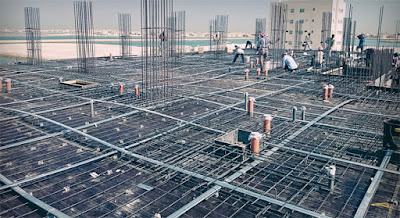Post Tension Slab
Post tension slab is a combination of conventional slab reinforcement and additional protruding high-strength steel tendons, which are consequently subjected to tension after the concrete has set.The basic element of a post tensioning system is called a tendon.A post tensioning tendon is made up of one or more pieces of prestressing steel, coated with a protective coating.
When concrete slab is stressed by the post tensioning method, it means the steel is being tensioned and the concrete is being compressed.Compression is a force that squeezes or crushes and tension is a force that pulls something apart.In concrete structures, this is achieved by placing high-tensile steel tendons/cables in the element before casting.When concrete reaches the desired strength the tendons are pulled by special hydraulic jacks and held in tension using specially designed anchorage fixed at each end of the tendon.This provides compression at the edge of the structural member that increases the strength of the concrete for resisting tension stresses.In this type of slab, cables are tied instead of reinforcement.In steel reinforcement, the spacing between bars is 4 inch to 6 inch whereas in post tension slab the spacing is more than 2 m.
Advantages Of Post Tension Slab
- It is suitable for the the expansive soil.
- It allows slabs are other structural members to be thinner.
- Cracks developed are tightly held together by means of tensioned tendons.
Disadvantages Of Post Tension Slab
- Required skilled labour.





No comments:
Post a Comment
If you have any doubts, Please let me know.